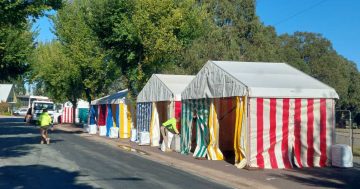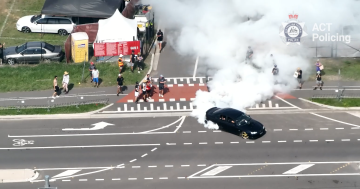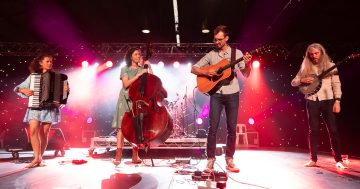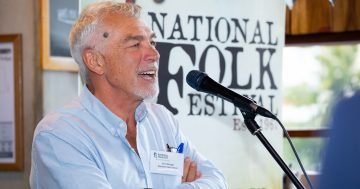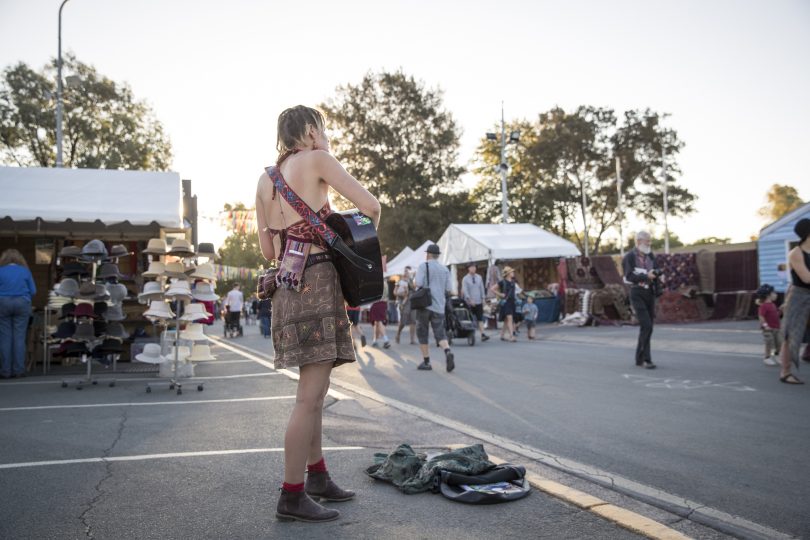
On the streets of the National Folk Festival. EPIC is a ready-made venue, albeit in need of a makeover. Photo: Photox.
The National Folk Festival has welcomed an upcoming Government-commissioned review of Exhibition Park but warned that any significant loss of the camping area or a move to another yet to be determined site could threaten the viability of the iconic Easter event.
Venues Canberra, in the Chief Minister’s and Economic Development Directorate, is set to announce a study into the long-term future of the 70-hectare Mitchell site, amid speculation that it will be redeveloped for housing as part of the Northbourne corridor urban renewal program being driven by the light rail project. The consultants will also take into account the soon to be developed nearby suburb of Kenny, where land is due to be released next year.
A smaller study is already being conducted by consultants Cardno to investigate the site, mainly for any contamination.
The studies and development speculation has put the Festival, which launches its official 2019 program this week, and other EPIC users on edge about the future of the site, scrambling to prepare a position paper.
Festival vice-president Graham Chalker said EPIC and its ageing infrastructure certainly needed upgrading but the Festival and organisers of other events held at the venue, such as the Canberra Show, wanted the site retained and developed into a world-class events centre.
It could even house the long sought after convention centre, he said.
“It’s important to look at this as not just the land value, what you could end up with if you filled it up with apartments, but the significant community benefit that we get from a variety of events that are held there,” he said.
Mr Chalker believed there was no comparable site of its size and facilities in the region and the cost of developing a greenfields site, as some have suggested in the Majura Valley, would be significant. None would have the convenience of EPIC.
He said a key advantage of EPIC was its location close to the city and accessibility, and being on the light rail route has only reinforced this.
The camping ground was a key part of the Festival experience and provided cheap accommodation to the 1200 volunteers who make the Festival possible, and younger visitors who could not afford hotel and other accommodation.
“The camping site is a really important part of things for us, and even more so for Summernats,” Mr Chalker said. “We’d really have to look at the business model. Certainly, for our volunteers it would be a problem. So yeah, it threatens the viability.”
The Government has already flagged a smaller footprint for EPIC, which the Festival could live with if possible residential development did not encroach and if the event could remain within its current boundaries.
The problem with nearby residential development is noise, and Mr Chalker said the current facilities would need soundproofing, and developers should be required to use double glazing and other technologies to keep out unwanted sound.
“At the moment most of the fixed buildings that we use are basically tin sheds without any soundproofing,” he said. “If they are going to go down the route of filling up the area they would need to start doing some work to soundproof the buildings.”
Mr Chalker said the Government had invested little in EPIC in recent years and the facilities, while adequate, were basically big barns that were costly to fit out.
Any upgrade could include built-in events infrastructure and more office space for the Festival and others to have permanent homes at EPIC instead of having to relocate every year.
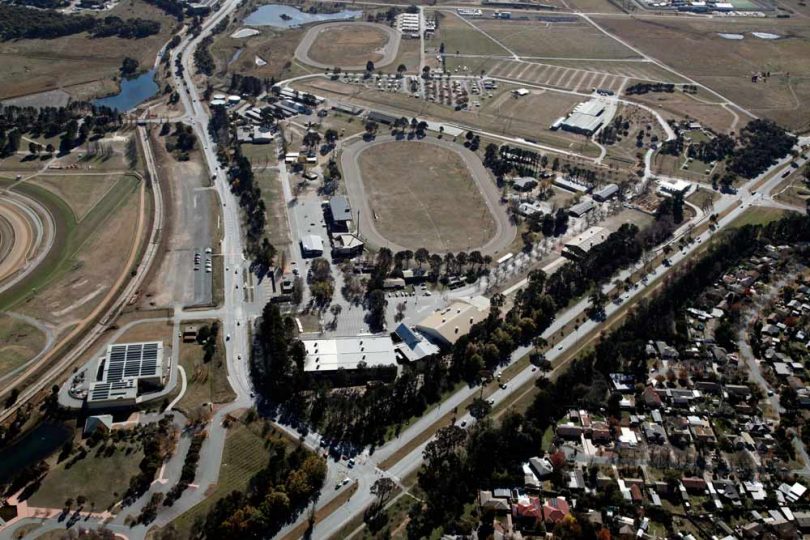
An aerial shot of EPIC, before light rail. Photo: EPIC.
The Festival believes developers should contribute to the cost of upgrading EPIC, as part of any deal to building housing on the site.
He believed an events centre like EPIC was compatible with the transformation going on around it, comparing its possibilities to Homebush in Sydney, which is home to a significant events centre surrounded by both residential and hotel accommodation, ‘and they seem to be able to accommodate a whole variety of uses’.
It’s a model the Canberra Show is examining as it moves to enhance its attractiveness and viability.
But Mr Chalker said it was not just the economic benefits that retaining and upgrading EPIC could bring but the advantages it would have for the Canberra community.
“Communities need more than just apartment blocks up and down there. You need a lot of accessible events,” he said.
“It’s not just us as users but where it fits into the community as a whole, and the importance of these cultural events and activities. If the Government wants an innovative entrepreneurial city, those sort of people like different activities and lots of creative things going on around them.”
Festival director Pam Merrigan said a review of the facility was long overdue because it was a tremendous asset for the ACT and fantastic for the economy.
“EPIC is the jewel in the crown given its location, and always having a footprint there would be a really valuable thing for the ACT Government,” she said.
Ms Merrigan hoped the review recognised the value of retaining the site for the long term and the benefits to be reaped down the track.
“It would be very sad to see its demise,” she said. “It will impact on a lot of people and those impacts would be like a domino effect.”
Mr Chalker said the Festival was already talking to other organisations, which should all be involved in a long-term plan for EPIC, and hoped to present a joint case to the study consultants.
“It’s important to bring in people like the Institute of Planners, the heritage people, and local community associations,” he said.
“At the very least understand what we’ve got and where we need to take it, and the benefits of keeping something like EPIC.”
Last year the Festival drew a total unique attendance of 14,581, up 2 per cent on 2017, but it will not only argue the event’s economic and tourism benefits to the ACT but its now significant place in the cultural landscape of the nation, with links to the National Library and the National Archives.
A recently re-negotiated five-year lease, with a 12-month get-out clause for either party, has given the Festival some breathing space.












